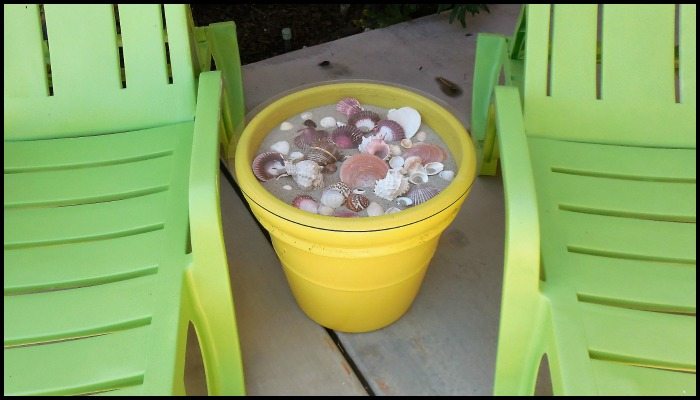
Is yours a beach-loving family? Then this custom table idea is for you!?
Making a seashell coffee table is a quick and easy project but what makes this really interesting is how creative your custom table can be. Look at this featured seashell table, made with a 20-inch terracotta pot! It’s filled with styrofoam and cardboard to not make the table too heavy for moving. It’s definitely perfect for any outdoor area!
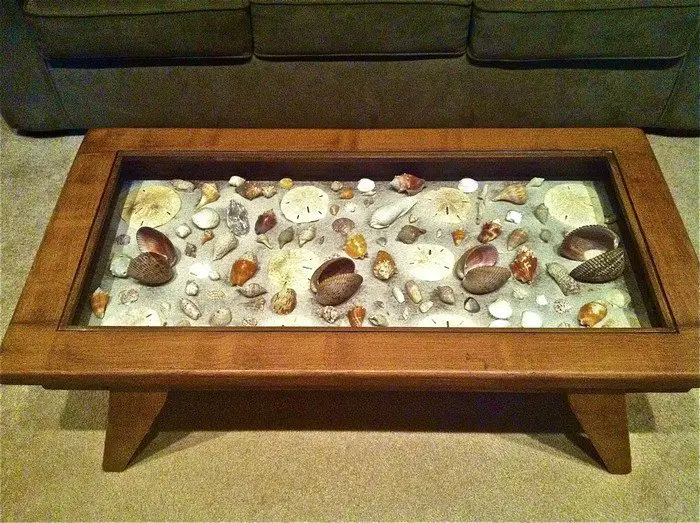
Now if you want, you can also build one more suitable for indoor use. Simply get a shadowbox table or modify an old table from a thrift store. Aside from a coffee table, it can also be a side table, a display table, or even a dining table.
This idea is a cute project and a nice gift for anyone who just loves the beach!
Do you know someone who would love to have a seashell coffee table?
Contents
Building a Seashell Coffee Table
Materials
- A shadowbox table or a terracotta pot with a glass top
- A bag of sand (preferably fine, clean sand)
- A variety of seashells (ensure they are clean and dry)
- Paint of choice (for the table or pot base)
- Styrofoam (to fill the terracotta pot, if using)
- Cardboard (to create a base layer inside the pot or shadowbox)
- Silicone adhesive (to secure shells and glass)
- Clear resin (optional, for a more polished finish)
Tools
- Cutter (for styrofoam and cardboard)
- Paintbrush
- Protective gloves (for handling adhesive and resin)
Instructions
- Prepare the Base:
- If using a shadowbox table, clean and sand any rough edges. For a terracotta pot, paint the exterior in your chosen color and let it dry completely.
- Cut a piece of styrofoam for the pot to fit snugly inside, followed by a layer of cardboard on top. This provides a solid foundation for your sand and shells.
- Layer the Sand:
- Pour sand into the shadowbox or on top of the cardboard in the pot, creating a layer about 1-2 inches thick. Level the sand with your hands or a small piece of cardboard.
- Arrange the Seashells:
- Begin placing your seashells onto the sand. You can create patterns, cluster them by type, or scatter them randomly, depending on your design preference. Press them slightly into the sand to secure.
- Secure the Shells (Optional):
- If you’re concerned about the shells moving, dab a small amount of silicone adhesive on the bottom of each shell before pressing it into the sand. Allow the adhesive to dry according to the manufacturer’s instructions.
- Seal the Top (Optional):
- If using a terracotta pot, apply silicone adhesive around the rim before placing the glass top on it. This ensures the top stays in place and seals the sand and shells.
- For a shadowbox or if you want a more polished look, mix and pour clear resin over the shells and sand, following the resin instructions carefully. This step is optional but creates a durable, glossy finish that protects the shells and sand.
- Final Touches:
- Once the adhesive (and resin, if used) has fully cured, your seashell coffee table is ready to be admired. Place it in your desired location and enjoy the unique, coastal charm it adds to your space.
Styling and Decor Tips
A seashell coffee table is not just a piece of furniture but a statement piece that brings the calming essence of the sea into your home. Styling and decorating around it requires a thoughtful approach to complement its unique beauty without overshadowing it.
Here are some styling and decor tips to enhance the ambiance of your space and make your seashell coffee table a standout feature.
Complementary Colors
Opt for a neutral color palette in the surrounding area to let the intricate details and colors of the seashell coffee table shine. Whites, beiges, and soft grays can create a serene backdrop that complements the natural hues of the shells.
Incorporate accent colors drawn from the seashells themselves. Hues of blue, green, or sandy tones can tie the room together, echoing the oceanic theme without overwhelming the senses.
Textural Harmony
Balance the hard textures of the seashells with soft furnishings. Plush rugs, comfortable throw pillows, and breezy curtains can add warmth and comfort, creating a cozy, inviting space around your seashell coffee table.
Introduce other natural elements to harmonize with the seashell coffee table. Wooden side tables, rattan chairs, or a sisal rug can enhance the table’s organic feel, connecting the indoors with the natural world outside.
Lighting and Ambiance
Utilize soft, diffused lighting to highlight the seashell coffee table. Table lamps with warm bulbs or strategically placed floor lamps can cast a gentle glow, accentuating the textures and colors of the shells.
For evening ambiance, arrange candles or lanterns around the table. The flickering light can create mesmerizing reflections on the shells, adding to the magical seaside atmosphere.
Accessorizing Thoughtfully
When accessorizing your seashell coffee table, less is more. Choose a few key pieces that complement the table without cluttering it. A glass vase with fresh flowers or a small, tasteful sculpture can enhance without overpowering.
Select decor items that echo the coastal theme, such as starfish decorations, coral pieces, or maritime books. These should accentuate the seashell motif without competing for attention.
Seasonal Touches
Adapt the decor around your seashell coffee table with the seasons. Light, airy accessories work well for spring and summer, while adding a thick, textured throw or warmer colored accents can transition the space for fall and winter.
By following these styling and decor tips, your seashell coffee table will serve as a functional piece of furniture and a central element of your home’s design, reflecting your personal style and the timeless allure of the ocean.
Click on any image to start the lightbox display. Use your Esc key to close the lightbox.![]()
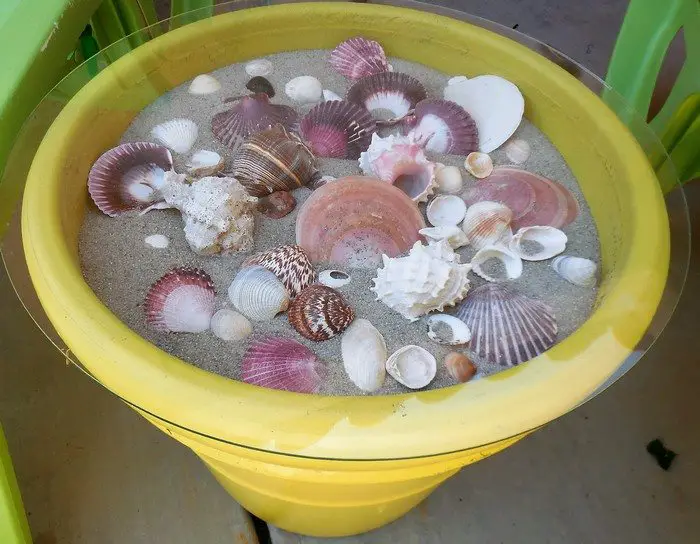
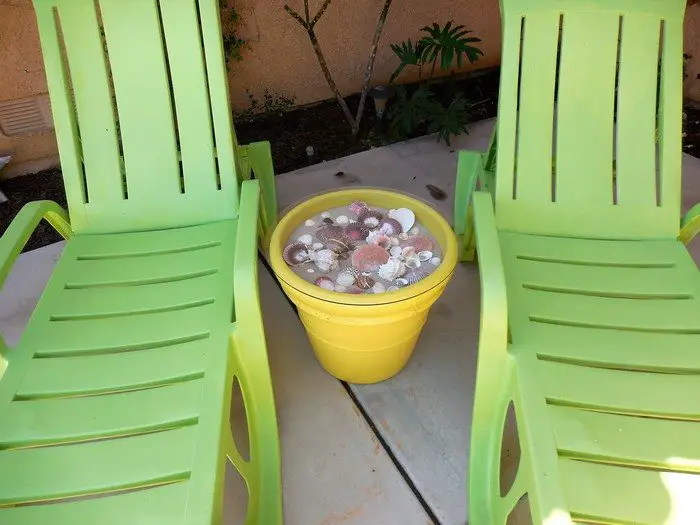

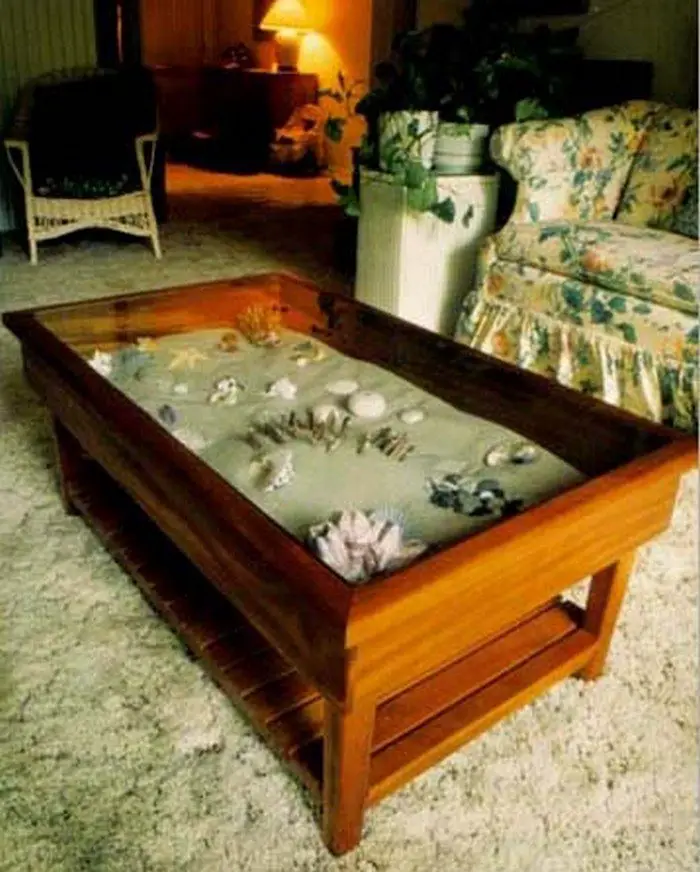
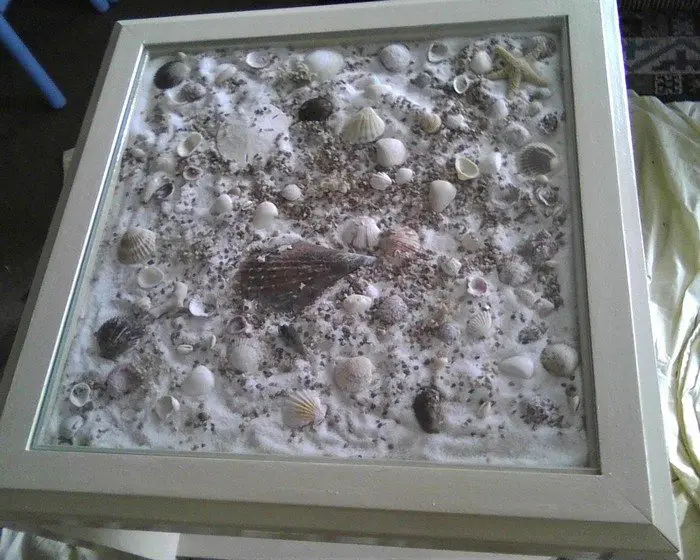
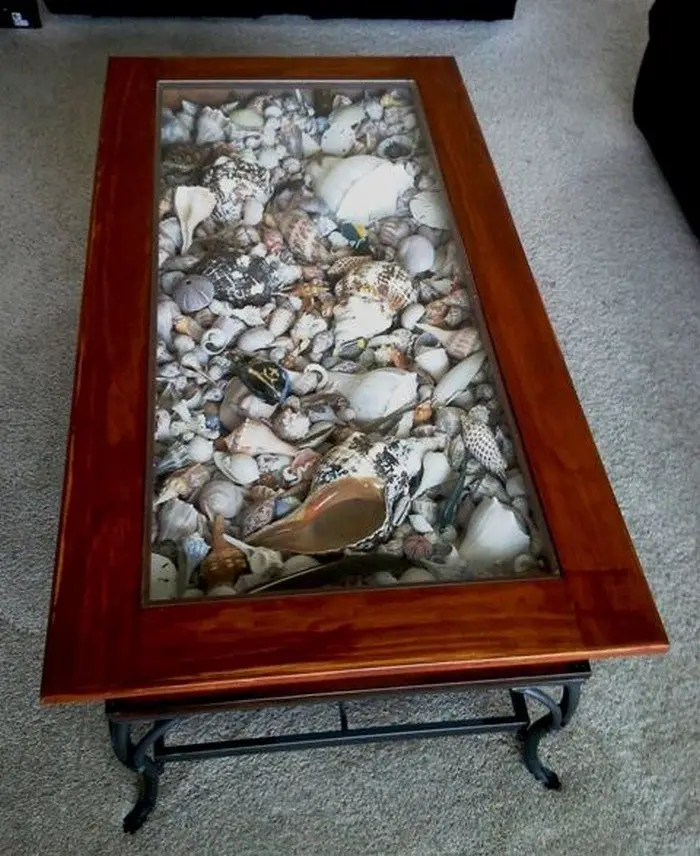



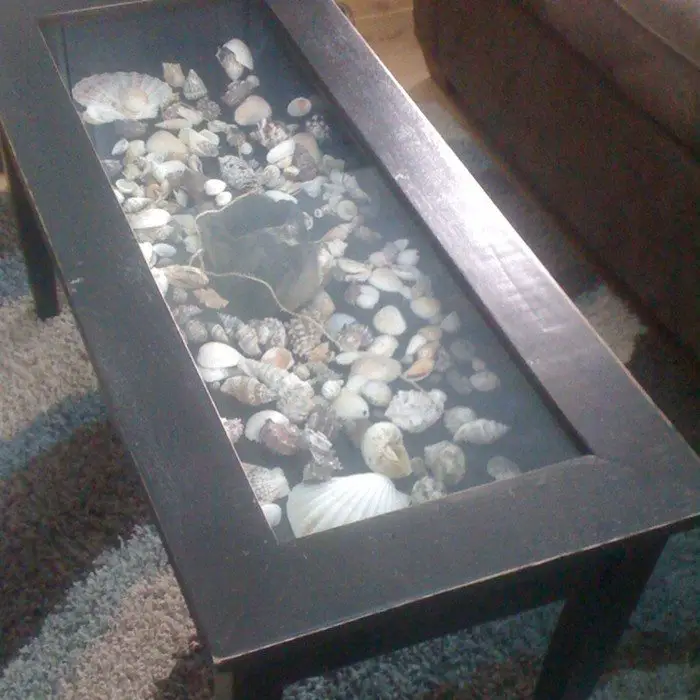

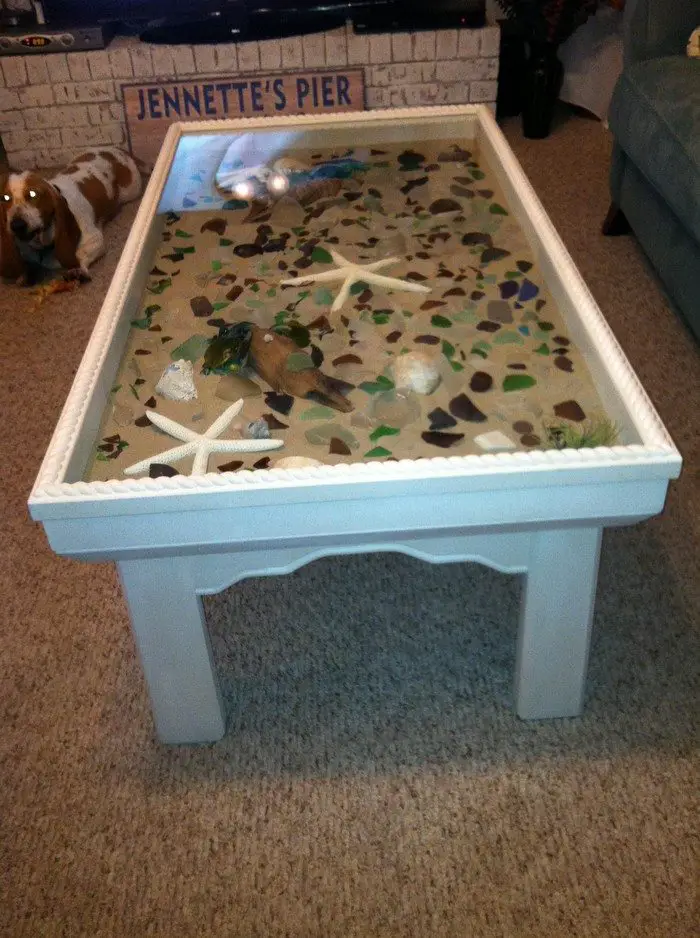
Maintenance and Care
Maintaining a seashell coffee table ensures its beauty and durability over time. Given its unique composition, special care is required to keep it looking as enchanting as the day it was made.
Below, we explore effective maintenance and care strategies tailored specifically for seashell coffee tables.
Regular Cleaning
- Dust Regularly: Use a soft, dry cloth or a duster to gently remove dust particles from the surface of your seashell coffee table. Dusting at least once a week prevents buildup and helps maintain the table’s luster.
- Gentle Washing: For a deeper clean, lightly dampen a soft cloth with water and a mild dish soap. Wipe the surface gently to remove any dirt or smudges. Immediately follow up with a dry cloth to remove any excess moisture, ensuring the seashells do not become waterlogged.
- Spot Cleaning: Promptly blot the area with a soft, damp cloth for accidental spills. Avoid rubbing, as this can push the spill deeper into the seashells or the table’s surface.
- Soft Brushing: To remove dust or debris from crevices between the seashells on your coffee table, use a soft-bristled brush, such as a paintbrush or a toothbrush. Gently brush away particles without applying too much force to avoid dislodging the shells.
- Air Drying: If your seashell coffee table is slightly damp after cleaning, allow it to air dry completely before placing any items back on its surface. This prevents moisture from being trapped under objects, which could damage the table or the shells.
Protecting the Surface
- Avoid Direct Sunlight: Place your seashell coffee table away from direct sunlight. Prolonged exposure can fade the colors of the shells and damage the table’s surface.
- Use Coasters and Placemats: Protect the table’s surface from scratches, heat, and moisture by using coasters under beverages and placemats under any decorative items or electronics.
- Mat Placement: Place a decorative mat or runner on your seashell coffee table for an added protection, particularly during gatherings or meals. This can prevent accidental scratches and spills from damaging the shells and the table’s surface.
- Adjust Humidity Levels: Maintain a stable indoor humidity level to protect the seashell coffee table from warping or the shells from deteriorating. Too much humidity can accumulate moisture, while too little can dry out the shells.
- Felt Pads: Attach felt pads to the bottoms of decorative items or anything on the seashell coffee table. This minimizes scratches and ensures the surface remains pristine.
- Avoid Heavy Objects: Avoid placing overly heavy objects on your seashell coffee table. Excessive weight can stress the table structure and damage the shell arrangement or the table itself.
Preserving the Shells
- Polishing: To keep the shells gleaming, apply a small amount of baby oil or mineral oil with a soft cloth. This will not only clean the shells but also enhance their natural color. Be sure to apply oil sparingly and infrequently to avoid a greasy residue.
- Avoid Harsh Chemicals: Never use harsh chemicals or abrasive cleaners on your seashell coffee table. These can damage both the shells and the table’s finish.
- UV Protective Coating: Consider applying a UV protective coating to the shells on your seashell coffee table. This helps prevent fading and discoloration caused by exposure to sunlight, ensuring the shells retain their vibrant colors and natural beauty.
- Moisture Control: Displace silica gel packets underneath or within the table (if it has a compartment) to control moisture levels. This is particularly beneficial in humid climates, protecting the shells from potential damage caused by excess moisture.
- Regular Inspection: Periodically inspect the shells for signs of wear or damage. Early detection of issues, such as cracks or loosening, allows for prompt repairs, maintaining the table’s aesthetic appeal and structural integrity.
Handling and Moving
- Careful Handling: When moving your seashell coffee table, always lift it rather than dragging it across the floor. Dragging can damage the legs and the surface beneath the table.
- Repairing Damage: Should any shells become loose or fall off, reattach them using a clear, waterproof silicone adhesive. Apply the adhesive carefully to avoid excess spillage, which could mar the table’s appearance.
- Team Lifting: When moving your seashell coffee table, enlist help to ensure it’s lifted evenly and securely. This prevents strain on any single part of the table and reduces the risk of dropping it, which could damage the table or the shells.
- Protective Covering: Before moving the table, especially for longer distances, wrap it in a soft blanket or bubble wrap. This provides an extra layer of protection against scratches, dings, or damage to the shells.
- Stable Placement: Once your seashell coffee table is in its new location, ensure it’s placed on a stable, level surface. An uneven floor could cause stress on the table’s structure, leading to potential damage over time.
- Avoid Direct Heat Sources: Keep your seashell coffee table away from direct heat sources, such as radiators or fireplaces. Extreme temperatures can cause the materials, including the shells, to expand or contract, potentially leading to damage.
By following these maintenance and care tips, your seashell coffee table will continue to be a cherished piece in your home, evoking the serene beauty of the sea for years to come.
DIY Challenges and Solutions
Creating a seashell coffee table is a rewarding project that brings a piece of the ocean’s tranquility into your home. However, like any DIY endeavor, it comes with its set of challenges.
Below, we outline common issues faced while creating a seashell coffee table and offer solutions to help you navigate these hurdles successfully.
Challenge: Selecting the Right Seashells
- Finding Variety and Size: One initial challenge is sourcing seashells that fit your vision in size, color, and variety.
- Solution: Visit various sources like craft stores, online marketplaces, or beachside souvenir shops to gather a wide selection. Consider also contacting local aquariums or marine conservation groups for sustainable sourcing ideas. Mixing larger focal shells with smaller ones creates visual interest and texture.
Challenge: Adhesive Selection and Application
- Choosing the Right Adhesive: Selecting an adhesive that is both strong enough to hold the shells and clear to maintain the aesthetic can be tricky.
- Solution: Opt for a high-quality marine epoxy or a clear, waterproof silicone adhesive. Both are durable and less noticeable once dried. Test the adhesive on a few shells and a similar surface before the final application to ensure it meets your expectations for hold and appearance.
Challenge: Arranging the Shells
- Creating a Cohesive Design: Figuring out how to arrange the shells in an appealing way that doesn’t look cluttered or random is often difficult.
- Solution: Lay out your shell arrangement on a flat surface before applying any adhesive. Take a photo of your final layout for reference. Start with larger shells and fill in gaps with smaller ones, considering color and texture balance. Use your photo as a guide during the actual application.
Challenge: Table Surface Preparation
- Preparing the Table for Shells: Ensuring the table surface is ready to securely hold the shells, especially if you’re repurposing an old table, can present issues.
- Solution: Clean the table surface thoroughly with a mild cleaner, then sand it lightly to create a texture for a better adhesive grip. If the table has a deep inset for the shells, consider lining it with a layer of clear resin before beginning your shell arrangement for a level surface.
Challenge: Finishing and Sealing
- Protecting the Completed Table: Once your seashell coffee table is assembled, protecting it from wear, tear, and spills is paramount.
- Solution: Apply a clear epoxy resin over the entire tabletop, including the shells. This creates a durable, waterproof surface that protects your design. Ensure you follow the resin application instructions closely for the best results, and consider doing a test pour on a similar but smaller scale first to get comfortable with the process.
Challenge: Weight Distribution
- Managing Table Weight: The addition of seashells and resin can significantly increase the weight of your coffee table, making it difficult to move.
- Solution: Plan the distribution of your shells and the thickness of your resin layer carefully to manage the overall weight. Use lighter materials like hollow terracotta pots or foam inserts beneath the table surface if you’re concerned about weight. Additionally, install casters on the bottom of the table legs for easier movement without compromising stability.
Challenge: Ensuring Longevity
- Preserving the Color and Integrity of Shells: Over time, the vibrant colors of your seashells may fade, and their structural integrity could be compromised.
- Solution: To protect the colors, apply a UV-resistant sealant over the shells after adhering them to the table. This sealant prevents fading caused by sunlight exposure and adds an extra layer of protection against physical damage. Positioning them away from direct sunlight for indoor tables can further preserve their appearance.
Challenge: Leveling the Tabletop
- Creating a Flat Surface: After arranging and securing the seashells, you might find the table’s surface uneven, making placing items on it challenging.
- Solution: Once the adhesive has dried, fill in any gaps between the shells with clear resin to create a level surface. Pour the resin slowly and evenly across the table, allowing it to settle into the spaces between shells. A heat gun can help remove air bubbles, ensuring a smooth finish.
Challenge: Mixing Materials
- Incorporating Different Textures: Combining seashells with other materials (like glass or wood) can be tricky, especially when aiming for a cohesive look.
- Solution: Plan your design thoroughly before beginning. Consider how they will fit into your overall layout if incorporating materials like driftwood or sea glass. Use these materials to create borders or accent pieces within your table design. Ensuring all elements are securely attached and harmonized with the seashell theme is key.
Challenge: Handling Sharp Edges
- Dealing with Sharp Seashells: Some seashells may have sharp edges, posing a risk of cuts or scratches.
- Solution: Before attaching sharp shells to your coffee table, gently sand down their edges with fine-grit sandpaper. This not only makes them safer to handle but also helps to prevent accidental injuries from touching the table. Always wear protective gloves during this process to protect your hands.
Challenge: Maintaining an Eco-Friendly Approach
- Sourcing Seashells Sustainably: Ensuring that your seashell collection process does not harm the environment can concern eco-conscious DIYers.
- Solution: Source shells from ethical suppliers who gather shells without damaging marine habitats. Alternatively, use shells collected from personal beach trips, ensuring they are not taken from protected areas. Research local regulations regarding shell collection to make informed, sustainable choices.
Challenge: Overcoming Creative Blocks
- Finding Inspiration: At times, visualizing the final design of your seashell coffee table can be challenging, leading to creative blocks.
- Solution: Draw inspiration from nature, interior design magazines, or online platforms like Pinterest. Sketch out several designs before deciding on one. Don’t hesitate to rearrange your layout multiple times on a flat surface until you find a design that resonates with you. Taking breaks and returning with fresh eyes can also help overcome any creative hurdles.
By anticipating these challenges and preparing with the outlined solutions, you can create a beautiful, durable seashell coffee table that captures the essence of the sea and becomes a treasured centerpiece in your home.
By anticipating these challenges and preparing with the outlined solutions, you can create a beautiful, durable seashell coffee table that captures the essence of the sea and becomes a treasured centerpiece in your home.
Conclusion
Crafting a seashell coffee table merges the beauty of the sea with functional art, creating a unique centerpiece for any living space. This DIY project allows for personal creativity and connection to nature and adds a serene, coastal charm to your home decor. Making and maintaining a seashell coffee table encourages sustainable practices and provides a fulfilling sense of accomplishment.
For more interesting coffee table ideas, check out our guide on making one from coat hangers!





